ISSN ONLINE(2278-8875) PRINT (2320-3765)
ISSN ONLINE(2278-8875) PRINT (2320-3765)
M. Naveen Kumar Reddy1, B.Hemalatha2
|
| Related article at Pubmed, Scholar Google |
Visit for more related articles at International Journal of Advanced Research in Electrical, Electronics and Instrumentation Engineering
A contactless measurement technique is providing to examine products during the process; a modular design of eddy current micro sensor was developed using various materials. The sensor consists of two parts, a singleturn excitation coil and an anisotropic magneto-resistance (AMR) sensor. The sensor is intended to be applied for the detection of cracks in ferrous and non-ferrous metals. The AMR sensor detects the change of the magnetic field induced in a sample by the excitation coil. Initial investigations were conducted to prove the capability of the completed eddy current micro sensor.
Keywords |
| Eddy current sensor, magnetic micro sensors, modular sensor concept |
I.INTRODUCTION |
| Modern production technology requires the acquisition of manifold process data. First of all, having basic information on the production process ensures certain reliability during the fabrication. Second, the acquired process data are used to verify the quality of a product at the end of the production. A new approach for the development of micro sensors with various materials is pursued in the project presented here. To come up with genetically intelligent (“genetelligent”) machine tools or components, various micro sensors were developed to gather process data not only during the production, but also later on during on entire life cycle. So far, a family of modular magnetic micro sensors covering both, force and strain measurements. In order to provide a contactless measurement technique to examine products the production process, a modular design of an eddy current micro sensor was developed. |
| The eddy current technique (ECT) is one of the most important non-destructive testing method and a common tool for the inspection of defects and material properties. Actually, ECT is applied in a wide application area. Another eddy current testing technique is pulsed eddy current testing. A major advantage of this type of testing is that there is no need for direct contact with the tested object. The measurement can be performed through coatings, weather sheetings, corrosion products and insulation materials. This way even high temperature inspections are possible. Compared to the conventional eddy current testing, pulsed eddy current testing allows multi-frequency operation. |
| This paper describes the design and the measurement principle of new eddy current micro sensor. The eddy current micro sensor is completely designed by applying Micro Electro-Mechanical Systems (MEMS) technology. As a result, the small dimensions of such a micro sensor enable the accumulation of information in areas which have not been accessible so far. |
II.SENSOR CONCEPT |
| The modular eddy current sensor consists of two parts, a single-turn excitation coil and an anisotropic magnetoresistance (AMR) sensor. Fig. 1 depicts the principle of the eddy current sensor. Eddy current sensing is based on detecting the interaction of the filed created by them. A coil located in close proximity of a conductive probe is excited by an alternating current. The resulting alternating magnetic field induces circular eddy current in the probe. The eddy currents themselves are surrounded by a circular alternating magnetic field, which weakens the coil’s driving field. The resulting magnitude of magnetization allows characterizing the probe surface. A material defect, e.g., a micro crack, causes a deformation of the current flow which results in a change of the total magnetic field. Changing the distance between sensor and probe also alters the magnetic of the eddy currents induced and, thus, the strength of the weakening filed. |
| The classical approach to detecting the eddy current is to use the inductivity effect. There are three ways to do so. One requires only one coil and measures the eddy currents result on the driving coils impedance. Alternatively, a transformer approach uses separate coils for excitation and for filed pickup. An excitation coil creates the magnetizing field while a pickup coil measures the superposition of the driving field and the field created by the eddy currents. The sensor described here follows this approach. It is mainly intended for proximity measurements involving planar surfaces or at least surfaces with radii greater than the sensor dimensions. |
III.DESIGN AND SIMULATION |
| To determine the optimal sensor design carried out using the simulation software COMSOL. The components for building up a magnetic micro sensor principally are the same ones used for macroscopic magnet devices. Magnetic flux maybe created by either a permanent magnet or an excitation coil. Depending on the current applied for energizing the coil, a direct or alternating magnetic field is generated. To guide the flux, a highly permeable material is required to achieve a low reluctance. If a high reluctance is required, it may be accomplished by forming an air gap. Furthermore, magneto elastic materials change their reluctance with strain, allowing to creating force sensors. A detection of flux typically is accomplished by field sensing; if the flux is alternating, it also may be defected by a detection coil taking advantage of Faraday’s law. |
| The simulations were conducted by modeling the excitation coil of the modular eddy current sensor as a ring out of Cu. The inner diameter is 360μm, the outside diameter is 560μm and its height amounts to 5μm. The simulations were conducted by modeling the AMR sensor of the modular eddy current sensor as of Fe, Al. The single-turn excitation coil has a footprint of 620μmX780μm. For the AMR sensor geometrically, a mender-like structure was chosen. The total length of the meander amounts to 855μm. The width of the leads is 20μm, and the insulation distance between the leads amounts to 5μm. |
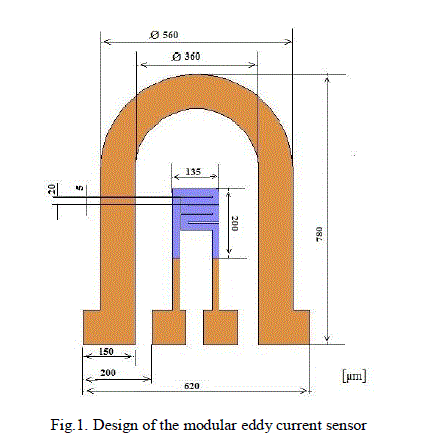 |
IV.EXPERIMENTAL RESULTS |
| The results were compared to the simulated magnetic field in the surface area. The sensor is simulated with Fe and Al materials. The sensor is simulated when the position of the sensor is exact on the surface of the sample and half of the sensor placed on the surface of the sample. The measurements were conducted for a variation of the magnetic field strength of 400A/m to 600A/m. |
| 4.1. When the AMR sensor of Fe material: |
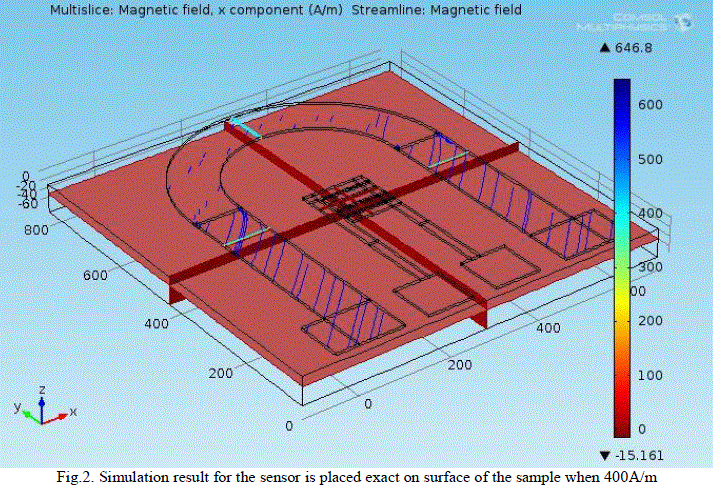 |
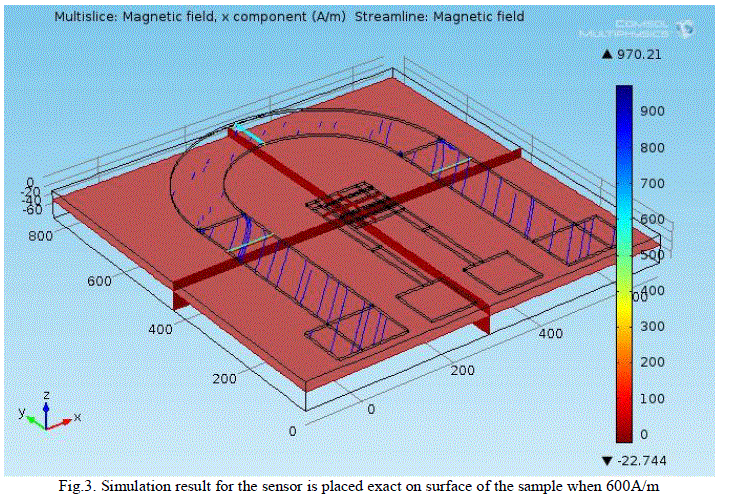 |
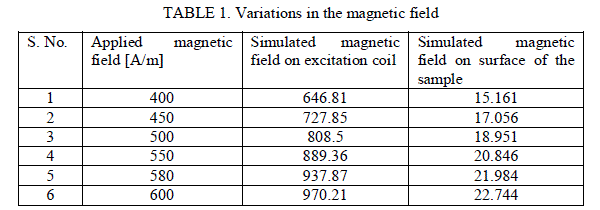 |
| The variations of the magnetic field on excitation coil and magnetic field on surface of the sample is shown in table 4.1. From the above table the variations of the magnetic field small changes up to the applied magnetic field 580A/m and after that excitation coil magnetic field will increase for small changes in applied magnetic field. |
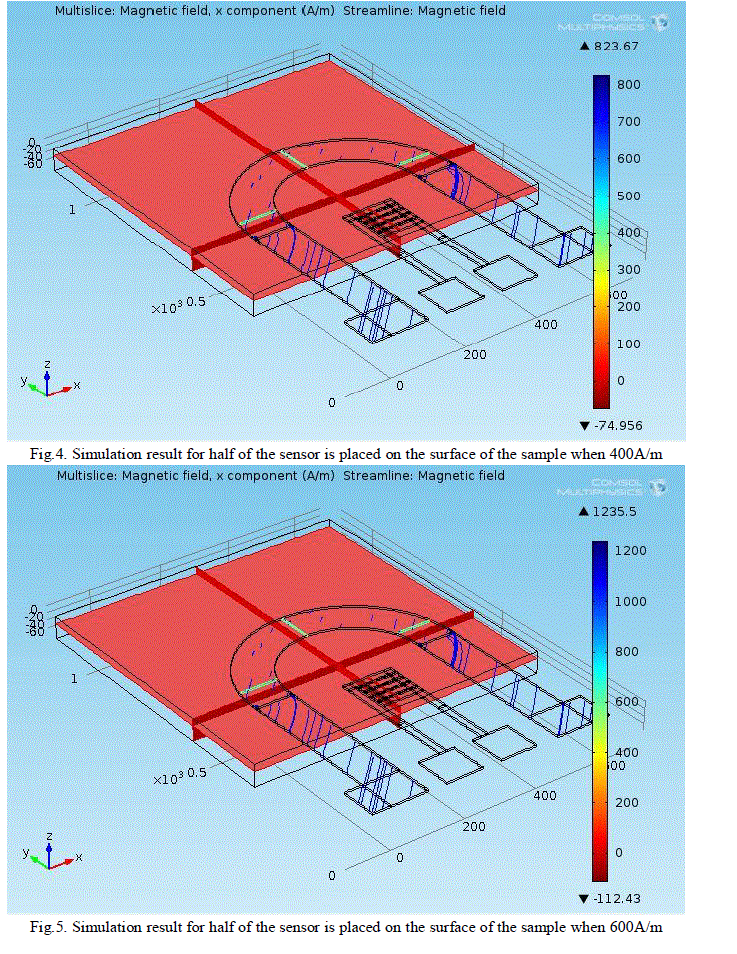 |
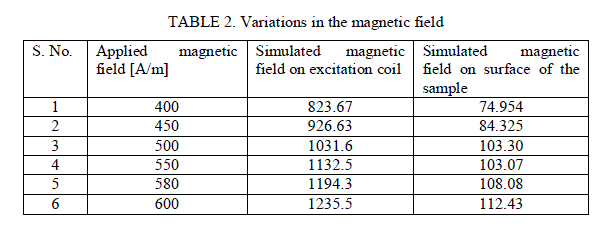 |
| From the above table the variations of the magnetic field small changes up to the applied magnetic field 580A/m and after that excitation coil magnetic field will increase for small changes in applied magnetic field. The results were compared to simulated magnetic field in the surface area of the sample in both cases is large change from initial simulation. |
| 4.2. When the ARM sensor of Al material: |
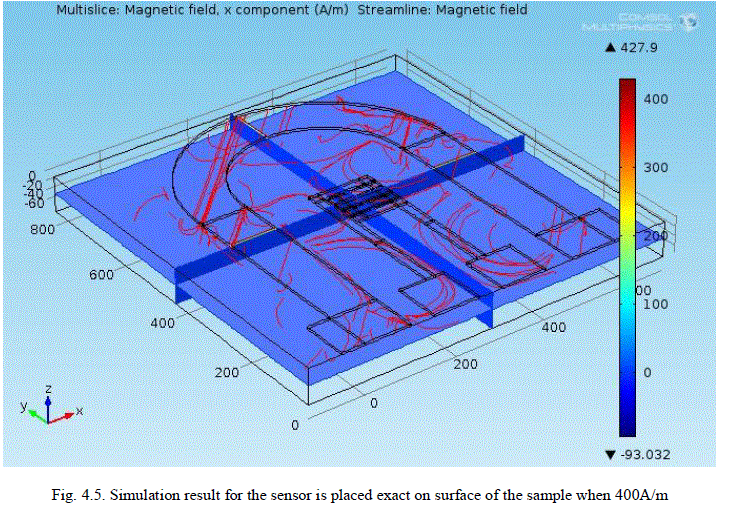 |
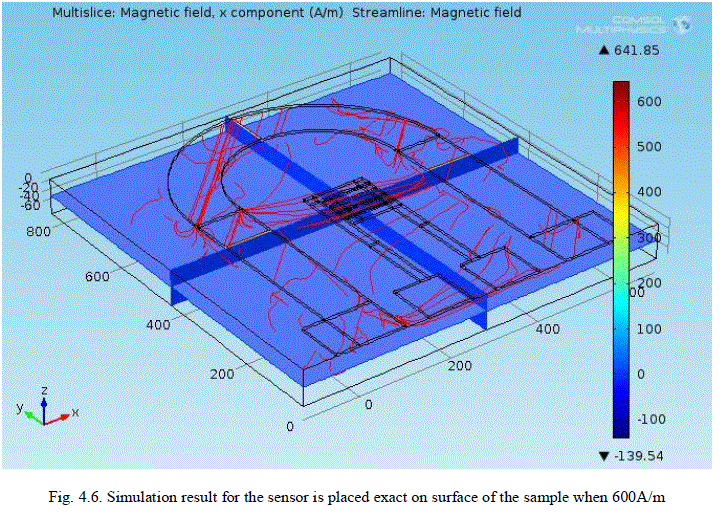 |
| In fig 4.5 and fig 4.6 the simulated magnetic field in both excitation coil and surface of the sample has more distortions, no uniform magnetic field present. |
V. CONCLUSION |
| A modular design of an eddy current sensor was successfully developed using various materials. Simulations show that the magnetic field variations in the excitation coil and surface of the sample. The sensor is simulated in two cases as exact on the surface of the sample and half of the sensor is placed on the surface of the sample. The results were compared with both simulations, the better performance will give when Fe material has been used because the more distortions occurred when Al material used. The small dimensions of such a micro sensor enable the accumulation of information in areas which have not been accessible so far. The sensor can be applied for the detection of defects smaller than 50μm in electrically conducting samples. |
References |
|